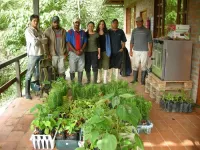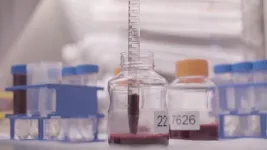(Press-News.org) Introducing Annotatability—a powerful new framework to address a major challenge in biological research by examining how artificial neural networks learn to label genomic data. Genomic datasets often contain vast amounts of annotated samples, but many of these samples are annotated either incorrectly or ambiguously. Borrowing from recent advances in the fields of natural language processing and computer vision, the team used artificial neural networks (ANNs) in a non-conventional way: instead of merely using the ANNs to make predictions, the group inspected the difficulty with which they learned to label different biological samples. Somewhat similarly to assessing why students find some examples harder than others, the team then leveraged this unique source of information to identify mismatches in cell annotations, improve data interpretation, and uncover key cellular pathways linked to development and disease. Annotatability provides a more accurate method for analyzing genomic data on single cells, offering significant potential for advancing biological research, and in the longer term, improving disease diagnosis and treatment.
A new study led by Jonathan Karin, Reshef Mintz, Dr. Barak Raveh and Dr. Mor Nitzan from Hebrew University, published in Nature Computational Science, introduces a new framework for interpreting single-cell and spatial omics data by monitoring deep neural networks training dynamics. The research aims to address the inherent ambiguities in cell annotations and offers a novel approach for understanding complex biological data.
Single-cell and spatial omics data have transformed our ability to explore cellular diversity and cellular behaviors in health and disease. However, the interpretation of these high-dimensional datasets is challenging, primarily due to the difficulty of assigning discrete and accurate annotations, such as cell types or states, to heterogeneous cell populations. These annotations are often subjective, noisy, and incomplete, making it difficult to extract meaningful insights from the data.
The researchers developed a new framework, Annotatability, which helps identify mismatches in cell annotations and better characterizes biological data structures. By monitoring the dynamics and difficulty of training a deep neural network over annotated data, Annotatability identifies areas where cell annotations are ambiguous or erroneous. The approach also highlights intermediate cell states and the complex, continuous nature of cellular development.
As part of the study, the team introduced a signal-aware graph embedding method that enables more precise downstream analysis of biological signals. This technique captures cellular communities associated with target signals and facilitates the exploration of cellular heterogeneity, developmental pathways, and disease trajectories.
The study demonstrates the applicability of Annotatability across a range of single-cell RNA sequencing and spatial omics datasets. Notable findings include the identification of erroneous annotations, delineation of developmental and disease-related cell states, and better characterization of cellular heterogeneity. The results highlight the potential of this framework for unraveling complex cellular behaviors and advancing our understanding of both health and disease at the single-cell level.
The researchers’ work presents a significant step forward in genomic data interpretation, offering a powerful tool for unraveling cellular diversity and enhancing our ability to study the dynamics of health and disease.
END
New method tracks the 'learning curve' of AI to decode complex genomic data
2025-01-06
ELSE PRESS RELEASES FROM THIS DATE:
Nutrient enrichment: an emerging threat to tropical forests
2025-01-06
Tropical forests, often referred to as the "lungs of the Earth," are essential for sustaining life on our planet. They provide clean air, water, and unparalleled biodiversity. While deforestation due to slash-and-burn agriculture, mining, and logging remains the most recognized threat, less visible but equally dangerous forces are at work. A new study reveals that nutrient enrichment – driven by human activities such as agriculture and fossil fuel combustion – poses a significant risk to the delicate dynamics of tropical forests.
The research, conducted by an international team of scientists ...
Scientists identify low-cost adsorbents for removing impurities from landfill gas
2025-01-06
Landfill gas, a mixture of gases produced when garbage breaks down within landfills, contains unwanted traces of siloxane compounds, which are chemical structures containing silicon and oxygen bonds and are found in various products like cosmetics and cleaning agents. These compounds can damage the equipment used to generate energy from landfill gas. In new research published in Environmental Progress & Sustainable Energy, investigators have identified low-cost adsorbents for siloxane removal from landfill gas.
The research highlights the potential of ...
CDC grant funds initiatives for breast cancer patients
2025-01-06
Weill Cornell Medicine has received a five-year, $2.3 million grant from the Centers for Disease Control and Prevention to improve equitable access to care, quality of life and survival outcomes for young people with all stages of breast cancer.
The grant will enable Weill Cornell Medicine to enhance care coordination for patients and caregivers to optimize support of physical, mental, emotional, social and spiritual needs, while offering culturally relevant resources and targeted interventions. The initiative ...
How can similar news stories influence financial markets? Here’s what investors need to know
2025-01-06
BINGHAMTON, N.Y. -- Have you ever noticed a swath of similar business news stories about a particular topic during a Google search, all of them appearing to be reported by different news outlets?
Why might a story on a news site in New York be so similar to one from a site in, for example, Wisconsin? It’s likely because the same media company owns them — and it’s become more commonplace nationwide as news outlets grapple with dwindling resources.
A new study co-authored by Flora Sun, assistant professor of accounting at Binghamton University’s School of Management, ...
Mixed signals: How the brain interprets social cues
2025-01-06
Imagine you’re at a dinner party, but you can’t smell the food cooking or hear the dinner bell. Sounds like a dream, right? What if it wasn’t?
“When we experience the world and interact with people, we use all our senses,” Cold Spring Harbor Laboratory Professor Stephen Shea says. “That’s true for animals and humans.” However, that’s not always the case in developmental disorders like autism. These conditions can affect how the brain processes incoming information, making it difficult to interpret the social cues that drive conversations, dates, and other ...
Climate extremes in 2024 ‘wreaking havoc’ on the global water cycle
2025-01-06
2024 was another year of record-breaking temperatures, driving the global water cycle to new climate extremes and contributing to ferocious floods and crippling droughts, a new report led by The Australian National University (ANU) shows.
The 2024 Global Water Monitor Report, involving an international team of researchers and led by ANU Professor Albert van Dijk, found rising temperatures are changing the way water moves around the planet, “wreaking havoc” on the water cycle.
“Rising ...
Acoustic sensors find frequent gunfire on school walking routes
2025-01-06
COLUMBUS, Ohio – A new study used acoustic sensors that detect the sound of gunfire to show how often children in one Chicago neighborhood are exposed to gunshots while walking to and from school.
Results showed that nearly two-thirds of schools in the Englewood neighborhood of Chicago had at least one gun incident within 400 meters (about one-quarter mile) of where children were walking home during the 2021-22 school year.
These findings suggest a need to redefine federal definitions of school gun violence to include indirect forms of violence that take place near schools, not only on school grounds, in order to more appropriately ...
New quantum sensing technology reveals sub-atomic signals
2025-01-06
Since the 1950s, scientists have used radio waves to uncover the molecular “fingerprints” of unknown materials, aiding in tasks as varied as scanning the human body with MRI machines and detecting explosives at airports.
These methods, however, rely on signals averaged from trillions of atoms, making it impossible to detect tiny variations between individual molecules. Such limitations hinder applications in fields like protein research, where small differences in shape control functionality and can determine the difference between health and disease.
Sub-Atomic Insights
Now, engineers at the University of Pennsylvania ...
Significant funding to ensure personalized treatments that work for rheumatoid arthritis
2025-01-06
In recent years treatment with powerful biologic and targeted synthetic therapies has changed the landscape for arthritis, but currently finding the right treatment for each person is a matter of trial and error. Only a proportion of patients with inflammatory arthritis respond to each expensive therapy, which results in unnecessary treatment and a long and often frustrating journey for patients, not to mention significant cost to the NHS.
University of Birmingham researchers have just been awarded £3.5 million funding from Johnson & Johnson to investigate ...
CryoSCAPE: Allen Institute scientists develop ‘suspended animation’ technique for blood draws that will aid research for underserved populations
2025-01-06
By Rachel Tompa, Ph.D
Your blood is a delicate mixture. Researchers and clinicians often use blood to learn what’s going on inside our bodies, in part because siphoning off a tube of blood is easier and less painful than taking biopsies of an internal organ.
But in some cases, it turns out that blood can be very different outside our bodies. When it comes to certain emerging research techniques, the clock starts ticking as soon as your blood hits the tube. As little as six to eight hours later, some aspects of your blood’s ...




